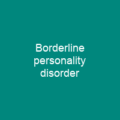Understanding Major Depressive Disorder: A Comprehensive Guide
Major depressive disorder (MDD) is a complex condition that affects millions worldwide, yet its intricacies are often misunderstood. Imagine the world as a vast ocean; depression can be likened to a stormy sea, with waves of sadness and despair crashing against the shores of one’s life. This article delves into the depths of MDD, exploring its symptoms, causes, diagnosis, treatment options, and societal impact.
Defining Major Depressive Disorder
MDD is characterized by pervasive low mood, loss of interest in activities, and a significant decline in daily functioning. These symptoms persist for at least two weeks, making life feel like an endless cycle of darkness. It’s important to note that MDD affects twice as many females as males, much like the moon’s gravitational pull influencing tides.
Diagnosis and Symptoms
The diagnosis of MDD is based on reported experiences, behavior, and mental status examination. The symptoms are numerous and varied: low mood, poor concentration, withdrawal from social situations, reduced sex drive, irritability, thoughts of death or suicide, insomnia, fatigue, headaches, digestive problems, and more. These symptoms can be overwhelming, making life feel like a never-ending struggle.
Impact on Daily Life
The disorder significantly impacts personal life, work, education, sleeping habits, eating habits, and general health. Relationships with family and friends are often strained, much like the tension between two planets in space. In older adults, cognitive symptoms may also arise, adding another layer of complexity to their lives.
Course and Prevalence
The course of MDD varies widely; some experience one episode lasting months, while others face a lifelong disorder with recurrent episodes. It’s the second-most common cause of years lived with disability after lower back pain. Elderly people may not present classical symptoms due to medication interactions and concurrent diseases, making diagnosis more challenging.
Etiology and Pathophysiology
The etiology of depression is complex, influenced by biological, psychological, social, genetic, and environmental factors. Genetics play a major role, with nearly 40% of individual differences in risk attributed to genetic factors. Other health problems such as chronic or terminal medical conditions, substance use, vitamin deficiencies, and hormonal changes can also contribute.
The biopsychosocial model proposes that these factors interact to cause depression. Pathophysiology centers around monoaminergic systems, circadian rhythm, immunological dysfunction, HPA-axis dysfunction, and structural or functional abnormalities of emotional circuits. The monoamine theory posits insufficient activity of monoamine neurotransmitters as the primary cause, but evidence is inconsistent due to effects on serotonin levels in healthy individuals.
Diagnosis
The American Psychiatric Association’s DSM-5-TR and ICD-11 criteria mark out typical depressive symptoms. A major depressive episode is characterized by severely depressed mood that persists for at least two weeks, with episodes categorized as mild, moderate, or severe.
Subtypes of MDD
The DSM-5 recognizes six subtypes: melancholic depression, atypical depression, catatonic depression, depression with anxious distress, depression with peripartum onset, and seasonal affective disorder. Each subtype has unique characteristics that can complicate diagnosis and treatment.
Management
Treatment options for MDD include pharmacotherapy, psychotherapy, exercise, ECT, TMS, or light therapy. Antidepressant medication is recommended as a first-line treatment choice for severe depression but not for mild cases unless ECT is planned. Psychotherapy is the preferred treatment for people under 18 and may help prevent depression.
For adults, antidepressant medication is recommended for moderate to severe depression, with SSRIs being better tolerated than tricyclic antidepressants. Treatment should be continued for at least six months to reduce the risk of relapse. Exercise has been found to be effective in treating major depression and may be as effective as medication or psychological therapies.
Psychotherapy
Talking therapies include psychotherapy, which can be delivered to individuals, groups, or families. Cognitive behavioral therapy (CBT) is a commonly studied form of psychotherapy that teaches clients to challenge negative thoughts and behaviors. CBT has the most research evidence for treating depression in children and adolescents.
Prevention and Screening
Screening and prevention efforts can reduce rates by 22-38%, with USPSTF recommending screening for depression over 12. Behavioral interventions are effective at preventing new onset depression, but barriers exist in the medical system that often lead to underrecognition and undertreatment.
Treatment Options
Options for treating major depression include pharmacotherapy, psychotherapy, exercise, ECT, TMS, or light therapy. Antidepressants have shown mixed results in treating acute and mild to moderate depression, but SSRIs such as escitalopram and sertraline have been found to be effective.
The combined use of antidepressants and benzodiazepines may improve effectiveness, but this effect may not last. Adding atypical antipsychotics like brexpiprazole to antidepressants may be considered for treatment-resistant depression, but the evidence is weak and the medication has potential adverse effects.
Electroconvulsive Therapy (ECT)
ECT is a standard treatment for major depressive disorder, particularly for those who are treatment-resistant. A round of ECT is effective for about 50% of people with treatment-resistant major depressive disorder. Follow-up treatment for ECT is poorly studied but half of those who respond relapse within twelve months.
Other Treatment Options
Other treatment options include transcranial magnetic stimulation (TMS), deep TMS, and transcranial direct current stimulation (tDCS). Sleep deprivation may improve depressive symptoms in some individuals, but its effectiveness is usually temporary and can cause side effects such as mania or hypomania.
Prognosis
A high proportion of people who experience a first major depressive episode will have at least one more. Poor outcomes are associated with factors such as inadequate treatment, severe initial symptoms, early age of onset, previous episodes, incomplete recovery after one year of treatment, pre-existing severe mental or medical disorder, and family dysfunction.
Conclusion
Major depressive disorder is a complex condition that affects millions worldwide. Understanding its intricacies can help us better support those who suffer from it. By recognizing the symptoms, seeking appropriate treatment, and addressing the underlying causes, we can work towards a brighter future for all.

You want to know more about Major depressive disorder?
This page is based on the article Major depressive disorder published in Wikipedia (retrieved on December 16, 2024) and was automatically summarized using artificial intelligence.





